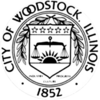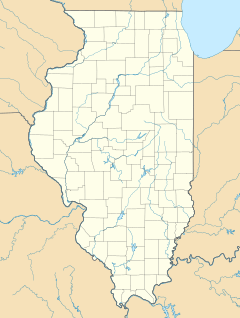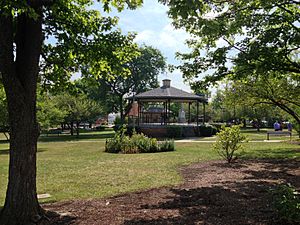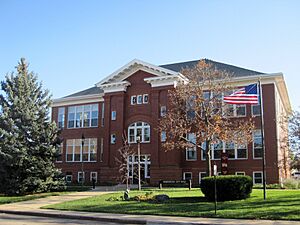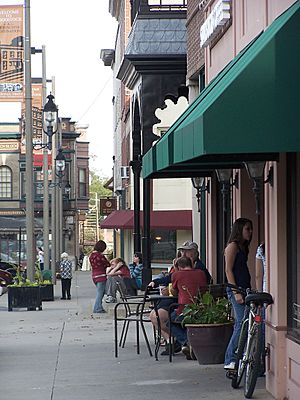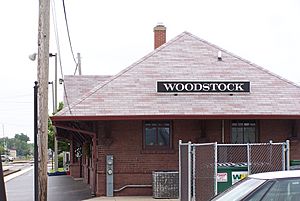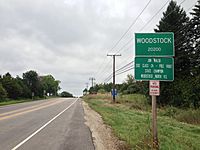Woodstock, Illinois facts for kids
Quick facts for kids
Woodstock
|
|||||
|---|---|---|---|---|---|
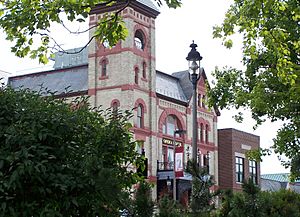
The landmark Woodstock Opera House building in historic downtown Woodstock
|
|||||
|
|||||
| Motto(s):
"True to Its Past; Confident of Its Future"
|
|||||
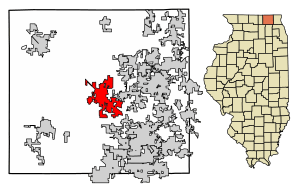
Location of Woodstock in McHenry County, Illinois.
|
|||||
| Country | United States |
||||
| State | Illinois |
||||
| County | McHenry | ||||
| Townships | Dorr, Greenwood, Hartland, Seneca | ||||
| Founded | 1852 | ||||
| Area | |||||
| • Total | 13.19 sq mi (34.15 km2) | ||||
| • Land | 13.19 sq mi (34.15 km2) | ||||
| • Water | 0.00 sq mi (0.00 km2) | ||||
| Population
(2020)
|
|||||
| • Total | 25,630 | ||||
| • Density | 1,943.58/sq mi (750.41/km2) | ||||
| Time zone | UTC-6 (CST) | ||||
| • Summer (DST) | UTC-5 (CDT) | ||||
| ZIP Code(s) |
60098
|
||||
| Area code(s) | 815/779 847/224 | ||||
| FIPS code | 17-83349 | ||||
| Wikimedia Commons | Woodstock, Illinois | ||||
| Website | www.woodstockil.gov | ||||
Woodstock is a city in Illinois, United States. It is the main city for the government of McHenry County. Woodstock is about 51 miles northwest of Chicago, making it one of Chicago's outer suburbs. In 2020, about 25,630 people lived there. The city's historic downtown area has a beautiful town square. This square is home to the famous Woodstock Opera House and the Old McHenry County Courthouse. In 2007, Woodstock was named one of the nation's "Dozen Distinctive Destinations" by the National Trust for Historic Preservation.
Contents
History of Woodstock
How Woodstock Got Its Name
Woodstock was first called Centerville. This was because it was in the middle of McHenry County. On September 4, 1843, it became the county seat. An early settler, Alvin Judd, planned the town. He included a two-acre public square. A courthouse and jail were built nearby in 1844.
In 1845, a resident named Joel Johnson suggested a new name. He wanted a more unique name than Centerville. The town was renamed Woodstock after Johnson's hometown in Woodstock, Vermont. In 1852, Woodstock became a village with Alvin Judd as its first president. After the Civil War, the population grew. Woodstock officially became a city in 1873. John S. Wheat was elected as the first mayor. A train line to Chicago was very important for the town's growth. It helped many industries start up in Woodstock.
Eugene V. Debs' Time in Woodstock
In 1895, a famous labor leader named Eugene V. Debs stayed in the Woodstock Jail. This happened after the Pullman labor strike in Chicago in 1894. Debs was the head of the American Railway Union. Officials sent him to Woodstock instead of Chicago. They worried he would have too many supporters in a Chicago prison.
Debs was held in a cell in the new Woodstock Jail. This jail was on the lowest floor of the Old McHenry County Courthouse. While in jail, Debs met important socialist thinkers. He also read books by Karl Marx. He later said the Woodstock Jail was one of his "greatest school[s]." He spent his time reading and writing many letters. When he was released in November 1895, crowds gathered in Woodstock Square. Debs had become a socialist and a national celebrity. He later ran for United States Presidency five times. He was the candidate for the new Social Democratic Party.
Woodstock: "Typewriter City"
In the early 1900s, Woodstock was known as "Typewriter City." It had factories for the Emerson Typewriter Company and the Oliver Typewriter Company. By 1922, workers in Woodstock made more than half of the world's typewriters. These companies were a big part of life in Woodstock. They had social clubs and baseball teams that played against each other. Emerson also had a popular band that played at public events.
In 1919, Emerson Typewriter became the Woodstock Typewriter Company. The city grew as demand for Woodstock typewriters increased. This continued through and after World War II. The company first sold typewriters for the war effort. After the war, soldiers who knew the brand bought them for their homes. The factory was used until 1970. Today, it has been turned into apartments.
Orson Welles and the Todd School
Woodstock played a key role in the early life of Orson Welles. He became a famous director, writer, and actor. In 1926, at age 10, he joined the Todd School for Boys in Woodstock. He stayed there for five years. This was his only formal education. The town and school left a strong mark on him. In 1960, he said Woodstock, Illinois, felt like his hometown.
At Todd School, Roger Hill, a teacher, guided young Welles. Hill later became the headmaster. He created a learning place that helped Welles' creativity. Welles could focus on subjects he liked. He put on his first plays and shows at Todd. He also performed at the downtown Woodstock Opera House. The stage there is now named after him. It was where he first directed a professional play in America.
Welles visited Woodstock many times after school. In July 1934, at age 19, he organized the Todd Theatre Festival. This was a six-week summer festival at the Woodstock Opera House. It featured actors from Dublin's Gate Theatre. His short film The Hearts of Age was filmed on the Todd School campus during the festival.
The Todd School for Boys closed in 1954. Some of its buildings were bought and used by other schools. Welles' old dorm was taken down in 2010.
Woodstock in Movies and TV
Planes, Trains and Automobiles (1987)
Some parts of the 1987 movie Planes, Trains, and Automobiles were filmed in Woodstock. One scene shows the main characters' rental car being towed. This happens in front of the old Courthouse. This movie helped Woodstock get noticed by film crews. Later, it was suggested for the movie Groundhog Day.
Groundhog Day (1993)
Woodstock is most famous for being the setting of the 1993 movie Groundhog Day. The movie stars Bill Murray. The story is set in Punxsutawney, Pennsylvania. However, the filmmakers chose Woodstock for its classic American look. Outdoor scenes were filmed around the downtown square and nearby streets. Signs from local shops can be seen in the movie.
Many famous movie locations have plaques in Woodstock. Visitors can take a walking tour to see them. In January 2020, some actors from the movie returned to Woodstock. This included Bill Murray, Brian Doyle-Murray, and Stephen Tobolowsky. They filmed a Groundhog Day-themed commercial for Jeep. It aired during the 2020 Super Bowl.
Other Appearances
Woodstock was the inspiration for the made-up town of Hawkins Falls. This was for the 1950s TV show Hawkins Falls, Population 6200. The city was also the main filming spot for the movie Bored Silly (2000). In August 2018, filming began in Woodstock for the 2019 HBO series Lovecraft Country. This show had famous producers like J. J. Abrams and Jordan Peele. A map of Woodstock can be seen in The Jackbox Party Pack 4 game Civic Doodle. It shows the historic square and local roads.
In September 2021, a second commercial was filmed in Woodstock. It was for Toyota and aired in December. Woodstock was also a main filming spot for the Amazon series Night Sky. It pretended to be the fictional town of Farnsworth, Illinois.
Local Culture in Woodstock
Local Newspaper
The Woodstock Independent is the local newspaper. It wins awards and is delivered weekly. It covers community news, events, and local government. It also reports on schools. The Independent also publishes The Torch. This is a magazine delivered for free to all Woodstock residents several times a year.
Music Scene
Woodstock has become a popular place for live music. It hosts local, national, and international artists. Many groups help support music in Woodstock:
- Liquid Blues
- Jazz on the Square
- Off Square Music
- Opera Woodstock
- RIFF Productions
- Woodstock Folk Festival
- Woodstock City Band
- Potts & Pans Steelband
Religion
Woodstock has many churches for different Christian groups. It also has a Jewish community. The Blue Lotus Buddhist Temple has been in Woodstock since 2002.
Education in Woodstock
Woodstock's public schools are part of District 200. This district started in 1969. It has one early learning center. There are six elementary schools and two middle schools. Woodstock also has two high schools: Woodstock High School and Woodstock North High School. New buildings were added after 2006. This helped with more students due to the area's growth.
Woodstock also has private schools. St. Mary Catholic grade school teaches students from kindergarten to 8th grade. Many students then go to Marian Central Catholic High School, also in Woodstock.
For college, residents often go to McHenry County College. It is in nearby Crystal Lake. Loyola University Chicago has a large campus in Woodstock. It is used for retreats and ecology studies. Aurora University also has its Woodstock Center downtown.
Woodstock's Economy
Top Employers
Woodstock has many important employers. Here are the top ones from 2018:
| # | Employer | # of Employees |
|---|---|---|
| 1 | McHenry County | 1,249 |
| 2 | Woodstock Community Unit School District 200 | 1,142 |
| 3 | Northwestern Memorial Hospital | 904 |
| 4 | Catalent | 590 |
| 5 | Charter Dura-Bar | 335 |
| 6 | Claussen Pickle Company | 300 |
| 7 | Walmart | 277 |
| 8 | Berry Plastics | 180 |
| 9 | Other World Computing | 180 |
| 10 | Menards | 140 |
Getting Around Woodstock
Public Transportation
Woodstock has a railroad station. It is almost the last stop on Metra's Union Pacific Northwest Line. This line starts in downtown Chicago. It ends in Harvard, Illinois. From Woodstock, 14 trains go to Chicago on weekdays. 13 trains return. About 400 to 500 people use the train daily. They travel to Chicago or other towns.
This direct train link was very important for Woodstock's growth. It is still a good way for people to get to Chicago. Woodstock uses the train system more than many other stations. This is true even for larger or closer towns. Other public transport is limited to Pace bus route 807. This bus connects downtown Woodstock with downtown McHenry.
Major Roads
U.S. Route 14 used to go through the center of downtown Woodstock. Now, a bypass road goes around the city's southwest edge. Illinois Route 47 runs through the city from north to south. Illinois Route 120 starts in northwest Woodstock. It then goes east past downtown and into the countryside.
Famous People from Woodstock
- Jack Allen, a baseball player
- Jessica Biel, an actress and model
- Cyrus Allen Black, a taxidermist and decoy-maker
- Michael J. Brown, an Illinois state representative
- Bryan Bulaga, a football player for the Green Bay Packers
- Rick Fletcher, an illustrator and cartoonist
- Chester Gould, creator of the Dick Tracy comic strip
- Ann Hughes, an Illinois state representative
- Marcellus L. Joslyn, a businessman
- Dana Nafziger, a football player
- Doug Oberhelman, former CEO of Caterpillar Inc.
- Scott Sobkowiak, a pitcher for the Atlanta Braves
- Barbara Stcherbatcheff, a best-selling author
- Lynn D. Stewart, a college basketball star and co-founder of Hooters
- Michele Weiner-Davis, a marriage therapist and author
- Orson Welles, a famous director, writer, and actor
- Gigi Goode, an American drag queen
- Brad S. Gregory, a history professor at the University of Notre Dame
- Rich Loiselle, a pitcher for the Pittsburgh Pirates
- Tamara Taxman, a Brazilian-American actress
Geography of Woodstock
In the 2010 census, Woodstock covered about 13.55 square miles (35.1 square kilometers). All of this area is land.
Population Information
| Historical population | |||
|---|---|---|---|
| Census | Pop. | %± | |
| 1860 | 1,327 | — | |
| 1870 | 1,574 | 18.6% | |
| 1880 | 1,475 | −6.3% | |
| 1890 | 1,683 | 14.1% | |
| 1900 | 2,502 | 48.7% | |
| 1910 | 4,331 | 73.1% | |
| 1920 | 5,523 | 27.5% | |
| 1930 | 5,471 | −0.9% | |
| 1940 | 6,123 | 11.9% | |
| 1950 | 7,192 | 17.5% | |
| 1960 | 8,897 | 23.7% | |
| 1970 | 10,226 | 14.9% | |
| 1980 | 11,725 | 14.7% | |
| 1990 | 14,353 | 22.4% | |
| 2000 | 20,151 | 40.4% | |
| 2010 | 24,770 | 22.9% | |
| 2020 | 25,630 | 3.5% | |
| U.S. Decennial Census 2010 2020 |
|||
| Race / Ethnicity (NH = Not Hispanic) | Pop 2000 | Pop 2010 | Pop 2020 | % 2000 | % 2010 | % 2020 |
|---|---|---|---|---|---|---|
| White alone (NH) | 15,511 | 17,748 | 16,456 | 76.97% | 70.56% | 64.21% |
| Black or African American alone (NH) | 195 | 513 | 737 | 0.97% | 2.07% | 2.88% |
| Native American or Alaska Native alone (NH) | 30 | 40 | 33 | 0.15% | 0.16% | 0.13% |
| Asian alone (NH) | 400 | 562 | 527 | 1.99% | 2.27% | 2.06% |
| Pacific Islander alone (NH) | 0 | 15 | 2 | 0.00% | 0.06% | 0.01% |
| Other race alone (NH) | 20 | 16 | 106 | 0.10% | 0.06% | 0.41% |
| Mixed race or Multiracial (NH) | 165 | 294 | 860 | 0.82% | 1.19% | 3.36% |
| Hispanic or Latino (any race) | 3,830 | 5,852 | 6,909 | 19.01% | 23.63% | 26.96% |
| Total | 20,151 | 24,770 | 25,630 | 100.00% | 100.00% | 100.00% |
See also
 In Spanish: Woodstock (Illinois) para niños
In Spanish: Woodstock (Illinois) para niños



